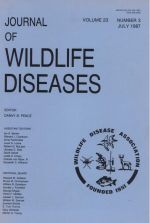Forty-eight newly captured free-ranging feral stallions (Equus caballus) from two different locations and six captive stallions were immobilized using combinations of etorphine hydrochloride, xylazine hydrochloride and atropine sulfate with or without acepromazine. Six animals were immobilized twice, 1 mo apart. The drugs were administered either intramuscularly (n = 13) or intravenously (n = 44). Mean immobilization time (±SE) after intravenous (i.v.) injection of etorphine, xylazine and atropine was 55 ± 4 sec (range 20 to 185 sec) compared to 708 ± 131 sec (range 390 to 1,140 sec) for intramuscular (i.m.) injection. Immobilization was reversed with i.v. administration of 3 to 11 mg diprenorphine hydrochloride and 16 to 24 mg yohimbine hydrochloride. Average time from administration to standing and walking was 86 ± 7 sec (n = 55). Reversal of etorphine-induced immobilization with an amount of diprenorphine equal to the etorphine and administered i.v. was as effective as a 2:1 ratio of diprenorphine to etorphine. Acepromazine had no effect on induction time, but decreased relaxation after immobilization and prolonged ataxia after reversal of the etorphine and xylazine. Eight free-ranging horses were immobilized in 708 ± 132 sec by darting with 5.5 mg etorphine, 1,300 mg xylazine and 15 mg atropine from a helicopter. Three animals died during the study: one immediately after reversal of an i.v. administration, one from a broken neck during induction from darting, and one was found a week later at the site of darting. Comparisons of hematological values before and 15 min after drug immobilization demonstrated a small but significant decline in hemoglobin, red cells, and hematocrit with no significant effects on calculated red cell parameters. The horses captured in the Flanigan area had significantly lower values of hemoglobin, hematocrit and red cells (P < 0.001, 0.01, and 0.06, respectively) than stallions from Beaty's Butte. This correlated with the poorer condition of the horses in the Flanigan area. The effectiveness of yohimbine as an antagonist for xylazine facilitated capture and immobilization of free-ranging feral horses and allowed their immediate release after handling with a minimum of postreversal depression.
How to translate text using browser tools
1 July 1987
RAPID REVERSIBLE IMMOBILIZATION OF FERAL STALLIONS USING ETORPHINE HYDROCHLORIDE, XYLAZINE HYDROCHLORIDE AND ATROPINE SULFATE
E. D. Plotka,
U. S. Seal,
T. C. Eagle,
C. S. Asa,
J. R. Tester,
D. B. Siniff

Journal of Wildlife Diseases
Vol. 23 • No. 3
July 1987
Vol. 23 • No. 3
July 1987
Anesthesia
blood
diprenorphine
Equus caballus
etorphine
feral horses
hematology




